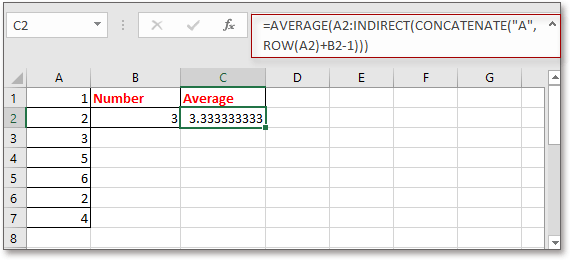Wie definiert man einen Bereich basierend auf dem Wert einer anderen Zelle in Excel?
Die Berechnung eines Wertebereichs ist für die meisten Excel-Benutzer einfach, aber haben Sie jemals versucht, einen Wertebereich basierend auf der Zahl in einer bestimmten Zelle zu berechnen? Zum Beispiel gibt es eine Spalte mit Werten in Spalte A, und ich möchte die Anzahl der Werte in Spalte A basierend auf dem Wert in B2 berechnen. Das bedeutet, wenn in B2 eine 4 steht, werde ich den Durchschnitt der ersten 4 Werte in Spalte A wie im folgenden Screenshot gezeigt berechnen. Nun stelle ich eine einfache Formel vor, um schnell einen Bereich basierend auf dem Wert einer anderen Zelle in Excel zu definieren.
Bereich basierend auf Zellenwert definieren
 Bereich basierend auf Zellenwert definieren
Bereich basierend auf Zellenwert definieren
Um eine Berechnung für einen Bereich basierend auf dem Wert einer anderen Zelle durchzuführen, können Sie eine einfache Formel verwenden.
Wählen Sie eine leere Zelle aus, in der Sie das Ergebnis anzeigen möchten, und geben Sie diese Formel ein: =AVERAGE(A1:INDIRECT(CONCATENATE("A",B2))), und drücken Sie Eingabetaste , um das Ergebnis zu erhalten.
1. In der Formel ist A1 die erste Zelle in der Spalte, die Sie berechnen möchten, A ist die Spalte, für die Sie die Berechnung durchführen, und B2 ist die Zelle, auf der die Berechnung basiert. Sie können diese Bezüge nach Bedarf ändern.
2. Wenn Sie eine Summe bilden möchten, können Sie diese Formel verwenden: =SUMME(A1:INDIREKT(VERKETTEN("A",B2))).
3. Wenn sich das erste Datum, das Sie definieren möchten, nicht in der ersten Zeile in Excel befindet, zum Beispiel in Zelle A2, können Sie die Formel wie folgt verwenden: =AVERAGE(A2:INDIRECT(CONCATENATE("A",ROW(A2)+B2-1))).
Zellen schnell nach Hintergrund- oder Formatfarbe zählen/addieren in Excel |
In einigen Fällen haben Sie möglicherweise einen Zellbereich mit mehreren Farben und möchten Werte basierend auf der gleichen Farbe zählen/addieren. Wie können Sie dies schnell berechnen? Mit Kutools für Excel'sNach Farbe zählen, können Sie schnell viele Berechnungen nach Farbe durchführen und auch einen Bericht über das berechnete Ergebnis erstellen. Laden Sie Kutools noch heute herunter und probieren Sie es aus! |
Kutools für Excel - Verleihen Sie Excel mit über 300 essenziellen Tools einen echten Schub. Nutzen Sie dauerhaft kostenlose KI-Funktionen! Holen Sie es sich jetzt |
Die besten Produktivitätstools für das Büro
Stärken Sie Ihre Excel-Fähigkeiten mit Kutools für Excel und genießen Sie Effizienz wie nie zuvor. Kutools für Excel bietet mehr als300 erweiterte Funktionen, um die Produktivität zu steigern und Zeit zu sparen. Klicken Sie hier, um die Funktion zu erhalten, die Sie am meisten benötigen...
Office Tab bringt die Tab-Oberfläche in Office und macht Ihre Arbeit wesentlich einfacher
- Aktivieren Sie die Tabulator-Bearbeitung und das Lesen in Word, Excel, PowerPoint, Publisher, Access, Visio und Project.
- Öffnen und erstellen Sie mehrere Dokumente in neuen Tabs innerhalb desselben Fensters, statt in neuen Einzelfenstern.
- Steigert Ihre Produktivität um50 % und reduziert hunderte Mausklicks täglich!
Alle Kutools-Add-Ins. Ein Installationspaket
Das Kutools for Office-Paket bündelt Add-Ins für Excel, Word, Outlook & PowerPoint sowie Office Tab Pro und ist ideal für Teams, die mit mehreren Office-Anwendungen arbeiten.
- All-in-One-Paket — Add-Ins für Excel, Word, Outlook & PowerPoint + Office Tab Pro
- Ein Installationspaket, eine Lizenz — in wenigen Minuten einsatzbereit (MSI-kompatibel)
- Besser gemeinsam — optimierte Produktivität in allen Office-Anwendungen
- 30 Tage kostenlos testen — keine Registrierung, keine Kreditkarte erforderlich
- Bestes Preis-Leistungs-Verhältnis — günstiger als Einzelkauf der Add-Ins